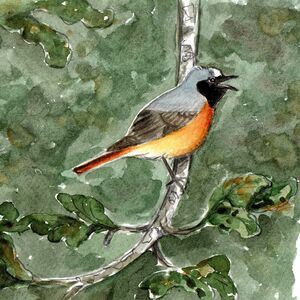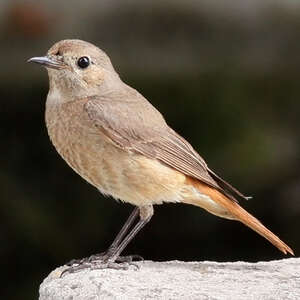Common Redstart
Phoenicurus phoenicurus - Rougequeue à front blanc
Identification
The wall nightingale, as it was formerly often called Common Redstart because of its reddishness and pleasant song, is a remarkable bird. The species has a strong sexual dimorphism. The nuptial male is easy to identify with its lower parts a bright orange-red, black head covering the forehead, the lores, parotids, cheeks and throat, and the white spot on the front of the cap which continues over the eyes, in strong contrast to the black underside. The orange color can be seen at the rump, the upperside of the tail and the outer rectrices, which can only be seen in flight and thus justifies the name of redstart. At rest, this color is hidden by the closed wings and the brownish central rectrices. The upper parts (top of the head, nape, mantle, and back) are gray-brown while the wings are darker, especially when the feathers are worn. The eye, very dark, blends into the black mask. The beak and feet are black. The female is more discreet, in its plumage as in its behavior. Its upper parts are brown-beige, darker brown on the wings and without gray nuances. The dark eye is surrounded by a fairly clear ocular ring. The underside is of a characteristic pale fawn, often speckled in appearance, with the throat and undertail a little clearer. It may be that with age, the throat darkens slightly. Upperside of the tail and tail are identical to those of the male. The young bird leaving the nest has a mottled appearance on the upper side, scaly on the underside, typical of the juvenile Muscicapids. After the first molt, he will become very similar to his mother. By the end of summer, the young male can be recognized by its grayer upper parts, its reddish undersides and its darker throat.The male of the subspecies samamisicus is characterized by a pale spot on the wing, formed by the white edges of the secondary and tertiary remiges, similar to the male Common Black Redstart. This is clearly seen in the field. The female Common Redstart can be confused with the female Common Black Redstart if one does not pay attention to the shade of its plumage which is always gray in the latter. The male, on the other hand, could theoretically be confused in the east of its range with a male Common Black Redstart of one of the subspecies with a reddish belly such as the aptly named ssp phoenicuroïdes which moreover can have a little white on the forehead. And to complicate matters, this subspecies is known to hybridize with the Common Redstart, producing confusing hybrids. Nevertheless, a male Common Redstart can always be recognized by its restricted black throat.
Subspecific information 2 subspecies
- Phoenicurus phoenicurus phoenicurus (Europe and n Africa to c Asia)
- Phoenicurus phoenicurus samamisicus (the Balkans and Greece to Uzbekistan, Turkmenistan and Iran)
Foreign names
- Rougequeue à front blanc,
- Colirrojo real,
- rabirruivo-de-testa-branca,
- Gartenrotschwanz,
- kerti rozsdafarkú,
- Gekraagde Roodstaart,
- Codirosso,
- rödstjärt,
- Rødstjert,
- žltochvost hôrny,
- rehek zahradní,
- Rødstjert,
- leppälintu,
- Europese Rooistert,
- cotxa cua-roja,
- Garðaskotta,
- pleszka (zwyczajna),
- erickiņš,
- pogorelček,
- Горихвостка-лысушка,
- シロビタイジョウビタキ,
- 欧亚红尾鸲,
- rödstjärt,
- 紅尾鴝,
Voice song and call
The song is typical. It's a rather short phrase, slightly melancholy, that always starts the same way: a hi followed by one or more tru (e.g. hi tru tru tru) leading to a short, babble-like, often melodious but sometimes a bit screeching riff, very variable according to individuals. The characteristic call is a long uit, which is reminiscent of a chaffinch's call, but louder, followed by one or more lightly dampened tit. That is its usual alarm call. Outside the breeding season, for example during migration, the uit becomes exclusive.
Habitat
The Common Redstart is a forest species. It shows a preference for deciduous forests but can also be found in mixed forests, even with predominantly coniferous forests to the north and east of its range.
Behaviour character trait
This is a shy and discreet bird. If it weren't for its sonorous song emitted from an obvious perch such as the top of a tree or a television antenna, the male would often go unnoticed despite its showy plumage.
Despite its temperamental nature, the species often nests near people, easily occupying the birdhouses provided for it. The female is not easy to observe and takes great pains to go to the nest without being seen. But at the slightest alarm, and it only takes a little to alarm them, the adults remain hidden and utter their anxious uit in long seemingly interminable series. The migratory travels occur during the night. The first migrants come back in the spring at the end of April in the south of the area and until May further up north. This return does not go unnoticed because upon arriving, the male sings to assert its territory. As for the summer departure, once the young have been emancipated in August and September, it goes unnoticed. At this time, one can observe small gatherings of migrants in the favourable places of agricultural areas with bushes. Again, it is the voice that draws our attention to them, these sonorous uits mentioned earlier. The last migrants leave the area of reproduction in October.Flight
Dietfeeding habits
Reproduction nesting
The Common Redstart is a cave-dweller. It builds its nest in a cavity, preferably in a tree, but also in rocky areas in a crevice.
In the built environment, it looks for the nooks of old walls. It readily adopts the artificial nesting boxes provided for small insectivorous birds, particularly tits. It prefers confined spaces with a small entrance hole. The nest is a cup made of vegetal elements, little tiles, leaves, roots and lined internally with hair and feathers. The female lays 5 to 7 eggs of a beautiful blue-green without spots which she alone incubates for 12 to 14 days. At fledging, the young are in the mottled livery characteristic of young Muscicapidae. They remain dependent on the parents for about two weeks. Once the first clutch is successfully completed, adults can begin a second breeding, at least in the south of its range.Geographic range
The Common Redstart is a Eurasian species that breeds from the Atlantic to Mongolia and from northern Scandinavia to North Africa and Iran in the south, mainly in the temperate and boreal latitudes. It avoids Atlantic islands except for the British Isles and Ireland (where it is rare). It is local and rare in the Maghreb (wooded mountains of Morocco and Algeria). Its winter range is disjointed, forming a band from Senegal to Somalia in the Sahelian zone, with a southern extension in East Africa to Rwanda and northern Tanzania.
Threats - protection
IUCN conservation status
concern
in the Wild
threatened
evaluated
The species is not globally threatened. However, in the second half of the 20th century in Western Europe, it suffered a pronounced decline probably due to multiple factors (drought in the Sahel, imposed forest management, etc.). It has since regained some of its numbers. For this small bird, long migratory journeys inevitably result in losses. It is confronted twice a year with the crossing of the Mediterranean and the Sahara, two unavoidable obstacles on its way to the winter quarters. The drought that has become endemic in the Sahel leads to high mortality. Mainly insectivorous, it also suffers from large-scale pesticide spraying against migrating locusts in Africa. On breeding sites, it is mainly habitat alterations (e.g. destruction of old orchards) and climatic events that have a negative impact on its demography.
Sources of information
- IOC World Bird List (v15.1), Gill, F and D Donsker (Eds). 2025-12-07.
- HBW Alive,
- Avibase, Lepage Denis
- xeno-canto, Sharing bird sounds from around the world,
- Les passereaux d'Europe, tome 1, P. Géroudet, M. Cuisin
Other sources of interest
 Specification sheet created on
14/07/2023 by Jean François
Specification sheet created on
14/07/2023 by Jean FrançoisTranslation by AI Oiseaux.net
© 1996-2025 Oiseaux.net
- Accipitriformes
- Aegotheliformes
- Anseriformes
- Apodiformes
- Apterygiformes
- Bucerotiformes
- Caprimulgiformes
- Cariamiformes
- Casuariiformes
- Charadriiformes
- Ciconiiformes
- Coliiformes
- Columbiformes
- Coraciiformes
- Cuculiformes
- Eurypygiformes
- Falconiformes
- Galliformes
- Gaviiformes
- Gruiformes
- Leptosomiformes
- Mesitornithiformes
- Musophagiformes
- Nyctibiiformes
- Opisthocomiformes
- Otidiformes
- Passeriformes
- Pelecaniformes
- Phaethontiformes
- Phoenicopteriformes
- Piciformes
- Podargiformes
- Podicipediformes
- Procellariiformes
- Psittaciformes
- Pterocliformes
- Rheiformes
- Sphenisciformes
- Steatornithiformes
- Strigiformes
- Struthioniformes
- Suliformes
- Tinamiformes
- Trogoniformes
































